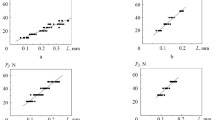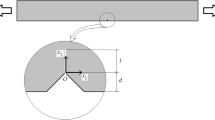Abstract
The results of an experimental dynamic fatigue study on glass-ceramic specimens containing indentation flaws are analysed in terms of the theory developed in Part 1. A Vickers indenter is used to introduce the flaws, and a conventional four-point bend apparatus to break the specimens. Base-line data for testing the essential theoretical predictions and for evaluating key material/environment parameters are obtained from “polished” surfaces, i.e. surfaces prepared to a sufficient finish to ensure removal of any pre-existing spurious stresses. The fatigue tests are carried out in water. Inert strength tests in dry nitrogen are used to “calibrate” appropriate equilibrium fracture parameters, with “dummy” indentations on selected control specimens providing a convenient measure of the critical crack dimensions at failure. Regression analysis of the dynamic fatigue data yields values for “apparent” kinetic parameters, which are converted to “true” kinetic parameters via the transformation equations of Part I. Regeneration of the fatigue function from the theory using the parameters thus determined gives a curve which passes closely through the experimental data points, thereby providing a self-consistent check of the formalism. The implications of the results in relation to the use of macroscopic fracture parameters in the prediction of strength properties for materials with small-scale flaws is an important adjunct to this work. Finally, a recommended procedure for the general testing of dynamic fatigue properties of ceramics using indentation flaws is described.
Similar content being viewed by others
References
B. R. Lawn, D. B. Marshall, G. R. Anstis and T. P. Dabbs, J. Mater. Sci. 16 (1981) 2846.
G. J. Bansal, W. H. Duckworth and D. E. Niesz Amer. Ceram. Soc. Bull. 55 (1976) 289.
B. J. Pletka and S. M. Weiderhorn, in “Fracture Mechanics of Ceramics”, edited by R. C. Bradt, D. P. H. Hasselman and F. F. Lange (Plenum Press, New York, 1978), Vol. 4, p. 745.
B. J. Pletka and S. M. Weiderhorn, J. Mater. Sci. 17(5) (1982), to be published.
R. F. Cook, B. R. Lawn, T. P. Dabbs and P. Chantikul, Commun. Amer. Ceram. Soc., 64 (1981) C-121.
D. B. Marshall, B. R. Lawn and P. Chantikul, J. Mater. Sci. 14 (1979) 2225.
G. R. Anstis, P. Chantikul, B. R. Lawn and D. B. Marshall, J. Amer. Ceram. Soc. 64 (1981) 533.
P. Chantikul, G. R. Anstis, B. R. Lawn and D. B. Marshall, J. Amer. Ceram. Soc. 64 (1981) 539.
G. K. Bansal and W. H. Duckworth, J. Mater. Sci. 13 (1973) 239.
B. G. Koepke, unpublished work.
B. R. Lawn, A. G. Evans and D. B. Marshall, J. Amer. Ceram. Soc. 63 (1980) 574.
K. Schönert, H. Umhauer and W. Klemm, “Fracture 1969”, Proceedings of the Second International Conference on Fracture, Brighton, April 1969, edited by P. L. Pratt (Chapman and Hall, London, 1969), p. 474.
T. A. Michalske, J. R. Varner and V. D. Frechette, in “Fracture Mechanics of Ceramics”, edited by R. C. Bradt, D. P. H. Hasselman and F. F. Lange (Plenum Press, New York, 1978), Vol. 4, p. 639.
B. R. Lawn and D. B. Marshall, in “Fracture Mechanics of Ceramics”, edited by R. C. Bradt, D. P. H. Hasselman and F. F. Lange (Plenum Press, New York, 1978), Vol. 3, p. 205.
E. R. Fuller, S. M. Weiderhorn, J. E. Ritter, and P. B. Oates, J. Mater. Sci. 15 (1980) 2282.
D. B. Marshall and B. R. Lawn, J. Amer. Ceram. Soc. 63 (1980) 532.
B. R. Lawn, D. B. Marshall and P. Chantikul, J. Mater. Sci. 17 (1981) 1769.
Author information
Authors and Affiliations
Rights and permissions
About this article
Cite this article
Cook, R.R., Lawn, B.R. & Anstis, G.R. Fatigue analysis of brittle materials using indentation flaws. J Mater Sci 17, 1108–1116 (1982). https://doi.org/10.1007/BF00543530
Received:
Accepted:
Issue Date:
DOI: https://doi.org/10.1007/BF00543530




